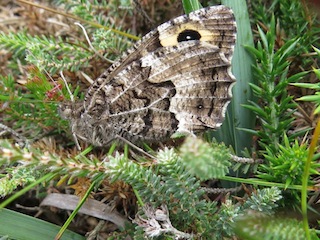 Grayling butterflies require plenty of bare earth for basking, so watch out for them in later summer along the trackways of the Lizard Downs. They are on the wing into September.
Grayling butterflies require plenty of bare earth for basking, so watch out for them in later summer along the trackways of the Lizard Downs. They are on the wing into September.
Photo: Steve Townsend
Scientific name: Hipparchia semele
Cornish name: ‘Tikki-dui’ is the general word for butterfly
Conservation status: UK Biodiversity Action Plan, Priority Species
What to look for:
- Colouring: Mottled brown wing underside, with black eyespot on underside of forewing (usually hidden when at rest with wings closed). In flight, the paler, orange-yellow bands on the upperside of the wings can be observed.
- Size: Wingspan 55 to 62 mm (the male is at the lower and the female at the upper end of this range).
- Where: Mainly coastal, but also inland on heaths, old quarries. It needs habitat with dry soils and lots of bare ground.
- When: On the wing July to September.
- Similar species: Other Brown butterflies, such as the Meadow Brown.
 The Grayling is a butterfly that loves to bask on bare earth and rocks in the sunshine. Holding its wings closed, the forewings folded behind the hindwings, it sits perfectly still, soaking up the warmth but barely visible thanks to the cryptic, mottled brown colouring of the underside of its wings. Cleverly, it also angles its wings so as to regulate its body temperature, and this can have the effect of creating very little shadow, therefore improving its camouflage even further. This makes it difficult to spot but, once seen, it can actually be quite photogenic: so confident is it in its disguise that it will let you get fairly close before escaping.
The Grayling is a butterfly that loves to bask on bare earth and rocks in the sunshine. Holding its wings closed, the forewings folded behind the hindwings, it sits perfectly still, soaking up the warmth but barely visible thanks to the cryptic, mottled brown colouring of the underside of its wings. Cleverly, it also angles its wings so as to regulate its body temperature, and this can have the effect of creating very little shadow, therefore improving its camouflage even further. This makes it difficult to spot but, once seen, it can actually be quite photogenic: so confident is it in its disguise that it will let you get fairly close before escaping.
This species is the largest of our Brown butterflies, and can be seen on the wing into September. Once fairly widely distributed across Britain, the Grayling has, along with many other butterfly species, been markedly declining, both in population levels and distribution. Threats include habitat destruction and encroachment of scrub, as the butterfly requires open, dry ground with plenty of bare earth. This makes the trackways on places such as the Lizard Downs excellent habitat for the Grayling.
Emerging in early July, its graceful, looping flight can be observed into September. It is a single-brooded butterfly. The eggs are laid on the main foodplants (including Sheep’s-fescue, Red Fescue, Bristle Bent and Early Hair-grass). After hatching, the caterpillars feed and then overwinter, before emerging in the spring, continuing to feed until June and then pupating just below the earth’s surface.
Did you know…?
…There are six subspecies of Grayling in Britain. In Cornwall, the nominate species H. semele semele is present.
…The Grayling’s requirement for open habitat with plenty of bare earth and rocks makes abandoned industrial sites a good habitat. In Cornwall, this means some of the best sites for the Grayling include old mining sites, as the butterfly can tolerate the metalliferous contamination.

More information and references:
Fox, R., Brereton, T.M., Asher, J., Botham, M.S., Middlebrook, I., Roy, D.B. and Warren, M.S., 2011. The State of the UK’s Butterflies 2011. Butterfly Conservation and the Centre for Ecology & Hydrology, Wareham, Dorset.
Wacher, J., Worth, J. and Spalding, A., 2003. A Cornwall Butterfly Atlas. Pisces Publications, Newbury, Berkshire.
Whalley, P. and Lewington, R., 2009. The Pocket Guide to Butterflies. Bounty Books, London.
Published: August 2014
Author: Amanda Scott
Photos: Steve Townsend
